MQ-8C Fire Scout
The MQ-8C is an unmanned adaption of the commercial Bell 407 helicopter built by Northrop Grumman and Bell Helicopter. The aircraft uses much of the same architecture as the MQ-8B Fire Scout, but features larger endurance (15 hours), payload, and cargo carrying capacity (2,600 pounds). The drone's requirements were largely driven by US Special Operations Command and the prototype "Fire-X" aircraft made its first test flight on December 10, 2010. The deployable MQ-8C version first flew in October 2013.
The Navy will build at least 19 MQ-8Cs (2 for testing and 17 operational) which were initially expected to first deploy at sea by 2014 but are now tracking for ship-based testing in 2017.
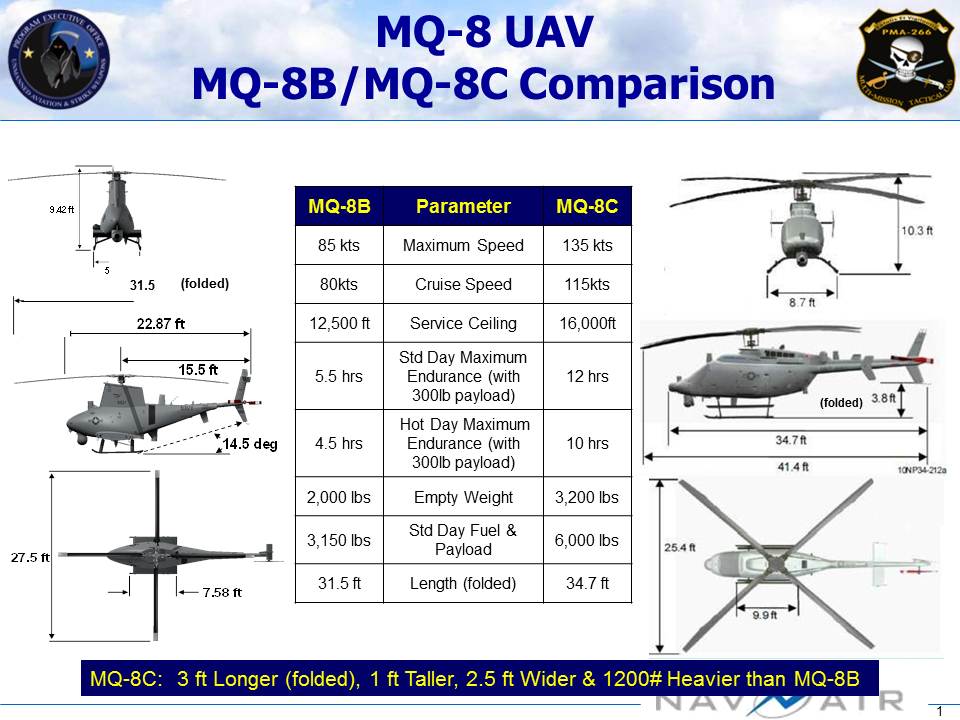
Image Courtesy NAVAIR
MQ-8C Fire Scout Ground Turns and Telemetry Testing onboard USS Montgomery (LCS 8)
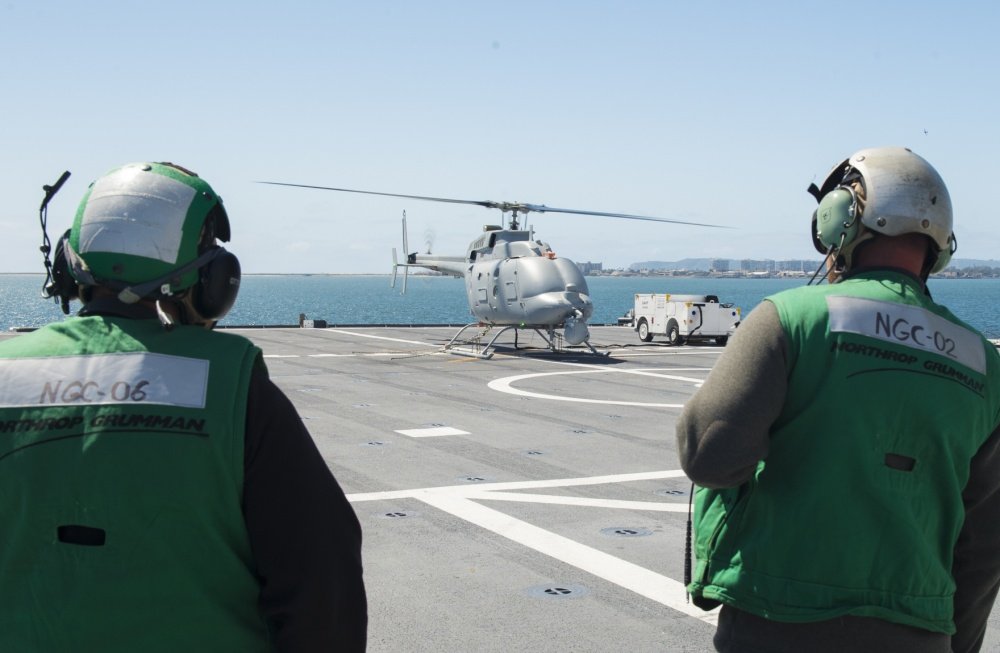
27 March 2017 - Northrop Grumman employees support MQ-8C ground turns and telemetry tests on board littoral combat ship USS Montgomery (LCS 8) while moored at Naval Base San Diego. This was the first test of the MQ-8C version of the Fire Scout on board an LCS. At see testing is planned later this spring. (U.S. Navy photo by Mass Communication Specialist 3rd Class Zachary Eshleman)
Navy Awards MQ-8C Fire Scout Radar Contract
17 October 2016 - Leonardo-Finmeccanica’s Osprey AESA radar has been picked to serve as look-out on-board the US Navy’s newly-upgraded unmanned helicopter, the MQ-8C Fire Scout. The contract will see Leonardo delivering an initial batch of 5 radars to the US Navy’s procurement organisation, the Naval Air Systems Command (NAVAIR), for testing and evaluation work.
NAVAIR then has an option to buy a larger quantity of the radars for use in real operations. Leonardo has already built a number of Osprey radars so the primary task under this contract is integration with the MQ-8C Fire Scout in time for first production deliveries.
Using its electronic beam technology to scan from high in the sky, crews back on-board will be able to spot even those threats who think they are hiding safely beyond the range of standard ship-based sensors. Employing high-frequency radio waves to ‘see’, an Osprey-equipped MQ-8C Fire Scout can detect targets at extremely long ranges, at night and even in stormy weather conditions when visibility is extremely poor. The radar’s world-first flat-panel technology also means it can be installed within the mold line of the helicopter rather than having to use an under-slung belly-pod.
Leonardo is an international leader in radar technology and the Osprey was selected in part because it is the world’s first radar to provide the needed coverage without moving parts or the need for a bulky external radome, all in a package light enough to fit on an MQ-8C Fire Scout.
The US Navy has chosen the 2-panel version of the Osprey which will provide a 240 degree instantaneous field of view and a range of digital modes including weather detection, air-to-air targeting and a ground moving target indicator (GMTI). The lack of moving parts inherent in the ‘E-Scan’ design means that repair and support costs are vastly reduced compared to alternative radar options. Osprey also provides an open architecture, meaning the US Navy can insert new software independently.
Northrop Awarded $108 Million Fire Scout Contract
12 September 2016 - Northrop Grumman Systems Corp. has been awarded a $108 million U.S. Navy contract for the procurement of 10 MQ-8C Fire Scout drones.
Work on the fix-price, incentive firm target contract will be performed in California, Alabama, Texas, Mississippi and various other locations. The job is expected to be completed in August 2019.
Naval Air Systems Command is the contracting activity.
Fire Scout is an unmanned helicopter system that provides intelligence, surveillance and reconnaissance, target acquisition, laser designation and battle management. It can operate from any air-capable ship or land base.
MQ-8C Fire Scout Completes Operational Assessment
30 November 2015 - The MQ-8C Fire Scout completed a three week operational assessment period Nov. 20 at Naval Base Ventura County at Point Mugu, California.
The OA included 11 flights totaling 83.4 flight hours where Fire Scout was tested against maritime and surveyed land targets to assess system performance, endurance and reliability of the unmanned helicopter.
“MQ-8C is meeting or exceeding its performance objectives and will deliver greater warfighting capabilities to the fleet in the future,” said Capt Jeff Dodge, Fire Scout’s program manager for Multi-Mission Tactical Unmanned Aerial Systems.
The MQ-8C will provide twice the endurance and three times the payload as the existing MQ-8B. It has a range of 150 nautical miles and a payload capacity of more than 700 pounds which provides unique situational awareness and precision target support for the Navy on land and at-sea with its multiple intelligence, surveillance and reconnaissance (ISR) capabilities.
The smaller MQ-8B, currently deployed on the USS Fort Worth (LCS-3), has flown more than 16,000 hours and demonstrated the ability to operate alongside the MH-60 manned helicopter during ship-based operations.
“The C model will greatly impact how we monitor, understand and control the sea and air space around small surface combatants,” Dodge said.
The MQ-8C has logged 427 flights and more than 730 flight hours to date. Initial ship-based testing is scheduled to begin in fiscal year 2017.
Fire Scout Demonstrates Long Endurance Flight
25 August 2015 - Northrop Grumman Corporation and the U.S. Navy successfully demonstrated endurance capabilities with the MQ-8C Fire Scout unmanned helicopter. On a planned 10+ hour flight and range out to 150 nautical miles flight from Naval Base Ventura County, Point Mugu; the MQ-8C Fire Scout achieved 11 hours with over an hour of fuel in reserve.
The long range, long endurance flight was part of a series of capability based tests used by the Navy to validate their concept of operations and previously tested performance parameters. The Navy conducted the demonstration with support of Northrop Grumman engineers.
"Endurance flights provide a full evaluation of the MQ-8C Fire Scout systems," said Capt. Jeff Dodge, program manager, Fire Scout, Naval Air Systems Command. "We can better understand the capability of the system and look at crew tasks and interactions in a controlled environment. This will allow us to adjust operational procedures to maximize the system's effectiveness."
This is a new flight record set for the MQ-8 Fire Scout; a system designed to provide persistent reconnaissance, situational awareness, and precision targeting support for ground, air and sea forces.
"Today's MQ-8C Fire Scout performance matches our model exactly. With adjustments, our production aircraft will have 12 hours of total endurance on a standard day. This prolonged endurance gives the Navy's commanders a tremendous operational advantage," said George Vardoulakis, vice president, medium range tactical systems, Northrop Grumman. "Increased time-on-station and fewer launch and recovery cycles better enables the Navy's diverse missions."
The MQ-8C Fire Scout completed its developmental flight test program earlier this year and has operational assessment planned for later this year. The MQ-8C Fire Scout has accumulated over 513 flight hours and flown 353 sorties.
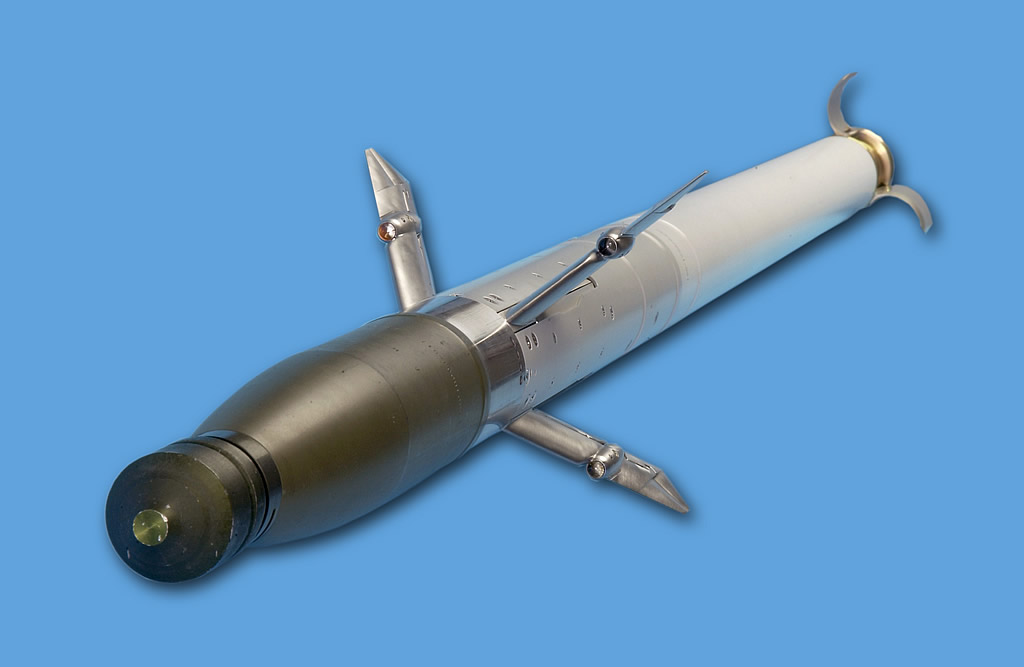
APKWS Rocket - Image Courtesy BAE Systems
Navy Discusses Future Fire Scout Capabilities
24 February 2015 - The U.S. Navy will test a number of new offensive upgrades to the MQ-8C Fire Scout unmanned helicopter system over the next several years.
Speaking at the Avalon Air Show in Melbourne, Australia, Commander James Borghardt, USN, Deputy Program Manager, Multi-Mission Tactical Unmanned Air systems (PMA-266), discussed planned upgrades to the drone's surface warfare capabilities in 2018 and mine counter measures systems 2020.
The aircraft's manufacturer, Northrop Grumman, plans to test fire BAE Systems' Advanced Precision Kill Weapon System (APKWS) off the MQ-8C in 2016. APKWS is a converted 2.75-inch Hydra rocket containing a semi-active laser guidance and control mid-section. Each weapon is less than $30,000, approximately a third the cost of Lockheed Martin's AGM-114 Hellfire missile. In 2013, the APKWS was launched off the Bell 407, the manned airframe which is the basis for the Fire Scout.
"The electro-optic and infrared payload is already on onboard along with auto-identification system and future increments include surface warfare and mine counter measure systems," said Borghardt.
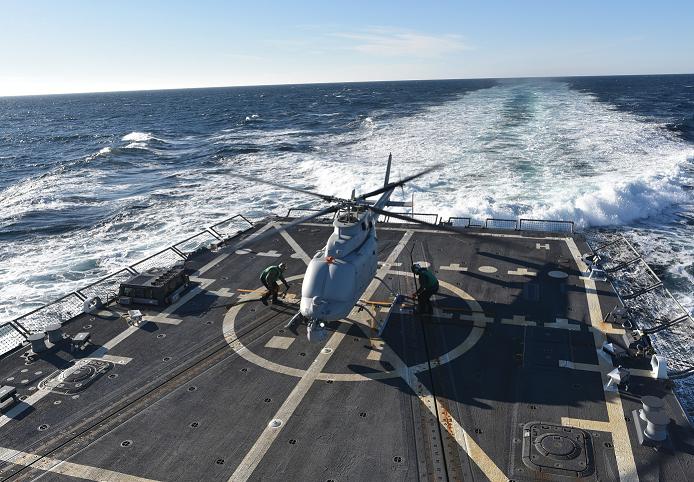
Northrop Grumman Photo
First Navy At Sea Tests for MQ-8C Fire Scout
23 December 2014 – The U.S. Navy and Northrop Grumman Corporation successfully flew the MQ-8C Fire Scout system for the first time off the guided-missile destroyer, USS Jason Dunham (DDG 109), December 16 off the Virginia coast.
After more than a year of land-based testing at Point Mugu, California, the MQ-8C Fire Scout grew its sea legs, making 22 takeoffs and 22 precision landings while being controlled from the ship's ground control station.
"The MQ-8C Fire Scout's flights from the USS Dunham represent a significant Navy milestone. This is the first sea-based flight of the MQ-8C and the first time an unmanned helicopter has operated from a destroyer," said Capt. Jeff Dodge, Fire Scout program manager at Naval Air Systems Command. "The extended capabilities will offer the Navy a dynamic, multipurpose unmanned helicopter with increased endurance, allowing for our ship commanders and pilots to have a longer on station presence."
"These dynamic interface tests are an essential part in clearing the operational envelope of the system and are proving the system's ability to operate off any air-capable ship," said George Vardoulakis, vice president for medium range tactical systems, Northrop Grumman Aerospace System. "We are on track to validate all of the critical performance parameters of this Navy asset and ready the system for deployment and operational use."
The U.S. Navy and Northrop Grumman Corporation successfully flew the MQ-8C Fire Scout system for the first time off the guided-missile destroyer, USS Jason Dunham (DDG 109), Dec. 16, 2014 off the Virginia coast. - Northrop Grumman Video
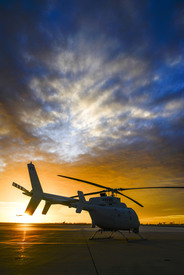
Northrop Grumman MQ-8C Fire Scout sits on the tarmac at Naval Base Ventura County, Point Mugu. (Photo by Northrop Grumman)
Northrop Grumman Delivers First Operational MQ-8C Fire Scout to the US Navy
3 December 2014 – Northrop Grumman Corporation has delivered the first operational MQ-8C Fire Scout unmanned helicopter to the U.S. Navy. The system will be used by ship-based commanders to improve the Navy's intelligence-gathering capabilities.
The MQ-8C is an upgraded version of the existing MQ-8B Fire Scout using a larger airframe. It can fly nearly twice as long and carry three times more intelligence, surveillance and reconnaissance payloads."The test program will run through the summer as we expect these aircraft to be ready for operations by year's end," said George Vardoulakis, vice president for medium range tactical systems with Northrop Grumman. The MQ-8C's first ship-board flight tests aboard the USS Jason Dunham (DDG 109) will be conducted this winter. The Navy will then assess the system for operational use. Northrop Grumman is under contract to build 19 MQ-8C Fire Scouts, including two test aircraft. The Navy plans to purchase 70 aircraft total.
MQ-8C Ready for Shipboard Testing
23 October 2014 –Northrop Grumman Corporation successfully completed precision sloped landing tests Aug. 27 with the MQ-8C Fire Scout at Naval Base Ventura County, Point Mugu, in preparation for at-sea testing.
MQ-8C Fire Scout has been undergoing rigorous flight testing and validation, which will culminate in the actual takeoff and landing on the deck of a Navy vessel at-sea. The MQ-8C is the company's latest variant of its successful Fire Scout unmanned aerial system, which performs intelligence, surveillance and reconnaissance missions for the U.S. Navy.
"The sloped takeoff and landing tests are designed to be as real as it gets to actually operating on a Navy ship," said Capt. Patrick Smith, Fire Scout program manager at Naval Air Systems Command. "The autonomous MQ-8C Fire Scout system is able to precisely track and understand the roll and pitch of the surface which resembles at-sea conditions."
The sloped landing platform was previously used to test and certify the MQ-8B Fire Scout for ship-based operations and is now being used for the more capable MQ-8C. The MQ-8C is utilizing the same proven autonomous system for takeoff and landings as the current MQ-8B model.
"The MQ-8C Fire Scout system is performing as predicted and as previously demonstrated during Fire-X testing back in 2011," said George Vardoulakis, vice president for Medium Range Tactical Systems, Northrop Grumman. "These tests enable a validation of our autonomous system and clear the way for dynamic interface testing onboard the ship."
Since its first flight Oct. 31, 2013, the MQ-8C Fire Scout has flown 219 flights and 287 hours. The most recent tests on the MQ-8C have consisted of electromagnetic testing, which assured compatibility with ship-based emitters (like radar) and an initial phase of dynamic interface testing, which looked at deck handling and communications networks. The MQ-8C's first ship-based series of flights are planned for later this year.
MQ-8C Fire Scout Prepares for Shipboard Flights
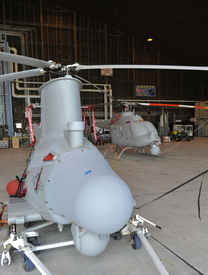 |
Two MQ-8 Fire Scouts sit in the Electromagnetic Environmental Effects (E3) facility at NAS Patuxent River, Maryland, May 1. The MQ-8B, left, recently equipped with a maritime search radar, and the new, larger MQ-8C, right, will both undergo testing to evaluate the unmanned helicopters' capability with other shipboard systems. (Photo Courtesy of U.S. Navy) |
5 May 2014 - In preparation for ship-board flights this spring, the Northrop Grumman Corporation-built MQ-8C Fire Scout will be tested for its ability to operate safely in the intense electromagnetic environment aboard U.S. Navy ships.
The MQ-8C Fire Scout uses specially-designed cages, known as Faraday cages, to protect sensitive equipment on the aircraft from signal interference.
"All Navy aircraft must go through electromagnetic interference testing to ensure they can operate safely in the ship environment," said Capt. Patrick Smith, Fire Scout program manager at Naval Air Systems Command. "We're confident that the design of the Faraday cages and other engineering work done on the MQ-8C Fire Scout will pass these tests."
The MQ-8C is based on a larger helicopter airframe and can fly almost twice as long and carry three times more intelligence-gathering sensor payloads than the MQ-8B variant.
During the program's design phase, a team of engineers created a new modular Faraday cage that protects electronic systems in flight.
"Almost 95 percent of what makes up the MQ-8B variant is reused in the MQ-8C to save money and the time needed to conduct a test program. However, we took advantage of lessons learned to incorporate a more modern shielding device in the new aircraft," said George Vardoulakis, vice president, medium range tactical systems, Northrop Grumman.
The Faraday cages are built by Summit Aviation in Somerset, Kentucky, and installed during final assembly at Northrop Grumman's Unmanned Systems Center in Moss Point, Mississippi.
Since first flight Oct. 31, the MQ-8C Fire Scout has flown 102 flights. The initial flight tests will validate that the autonomous control systems of the helicopter are working properly before its first ship-based demonstration.
Northrop Awarded Contract to Equip MQ-8C with Electronic Warfare Sensors
1 May 2014 - Northrop Grumman Aerospace Systems, San Diego, California, is being awarded a sole-sourced $10,833,670 cost-plus-fixed-fee contract for the development and integration of a Multi Capability Pod (MCAP) onto the MQ-8C, including the purchase of two MCAPS and one MCAP Mass Model. The MCAP provides multiple electronic warfare sensors for employment in the littorals. Work will be performed in Rancho Bernardo, California (59 percent); Chantilly, Virginia (40 percent); and Fort Worth, Texas (1 percent), and is expected to be completed in June 2015.
MQ-8C Surpasses 100 Flight Hours
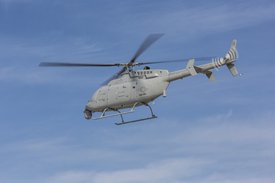
19 March 2014 - According to Naval Air Systems Command, on 10 March the MQ-8C unmanned helicopter surpassed 100 flight hours. The upgraded Fire Scout will continue testing at Point Mugu, California this year. In July, the Navy will conduct at-sea testing with the MQ-8C aboard USS Jason Dunham (DDG 109) to test the vehicle's take-off and landing procedures. The MQ-8C's initial deployment is planned for 2015.
Second MQ-8C Takes Flight
13 February 2014 - Northrop Grumman Corporation and the U.S. Navy successfully flew the second MQ-8C Fire Scout unmanned helicopter for the first time. Conducted at Naval Base Ventura County, Point Mugu, California, the flight will allow the team to ramp up testing efforts to prepare the system for operations.
Current tests are focused on validating the flight capabilities of the MQ-8C before ship-based flights take place this summer.
"The addition of the second MQ-8C means we can begin testing on more components and equipment needed to operate the system as an intelligence-gathering platform," said George Vardoulakis, vice president for medium range tactical systems at Northrop Grumman. "This includes installing and conducting tests on the full sensor suite."
Fire Scout uses on-board sensors to capture full-motion video, identify targets and then distribute the information in real time to various users. This allows ship-based commanders to maintain awareness of a specified area or keep an eye on a target of interest for long periods of time.
"Flight testing has been very successful since the system's first flight Oct. 31," said Vardoulakis. "We've completed 41 flights totaling 66 hours. This accomplishment points back to the maturity of the MQ-8C's autonomous control systems that allow the aircraft to operate as an unmanned system."
MQ-8C Makes First Flight
31 October 2013 – Northrop Grumman Corporation and the U.S. Navy successfully completed the first flight of the next-generation MQ-8C Fire Scout unmanned helicopter at Naval Base Ventura County, Point Mugu, California.
At 12:05 p.m. the MQ-8C Fire Scout took off and flew for seven minutes in restricted airspace to validate the autonomous control systems. A second flight that took off at 2:39 p.m. for nine minutes was also flown in a pattern around the airfield, reaching 500 feet altitude.
The aircraft was operated by a ground-based Navy/Northrop Grumman flight test team also located at Naval Base Ventura County.
Northrop Delivers Upgraded Fire Scout to USN
19 July 2013 - Northrop Grumman delivered its first upgraded MQ-8C aircraft to the Navy in early July in preparation for ground and flight testing.
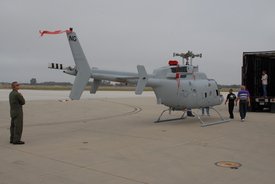
The aircraft will be tested by VX-30 squadron at the Naval Base Ventura County, California, Point Mugu sea test range.
“Ground and flight testing are the next steps in meeting the urgent requirement for maritime intelligence, surveillance and reconnaissance,” said George Vardoulakis, Northrop Grumman vice president for medium range tactical systems. “Testing on the Naval Air Systems Command test range provides us with extended air space to conduct and demonstrate long endurance and systems testing in a maritime environment.”
Northrop Awarded Fire Scout Contract Add-On
13 March 2013 - The Navy awarded Northrop Grumman a $71 million contract to procure six additional MQ-8C Fire-X variants, for a total of 30 aircraft.
George Vardoulakis, vice president for tactical unmanned systems with Northrop Grumman's Aerospace Systems sector said, "this contract provides significant momentum for the work Northrop Grumman and its supply chain partners are doing to meet the Navy's requirements."
Northrop Grumman Adapting STARlite Radar for MQ-8C
23 October 12 - Northrop Grumman has announced that it will adapt the AN/ZPY-1 STARLite radar to sell to the Navy for the Fire-X unmanned helicopter. The ground surveillance radar will be modified for maritime use. The STARlite's Synthetic Aperature Radar (SAR) features a strip mode, where the radar imagery is either parallel to the aircraft flight vector or along a specified ground path independent of the aircraft flight path, and a spot mode, or high resolution image of a specific location. The radar's Ground Moving Target Indicator (GMTI) provides moving target locations overlaid on a digital map. The Dismount Moving Target Indicator (DMTI) mode can track a man size object moving at a range of 8 km.
Northrop Grumman STARlite promotional video.
Navy to Establish Dedicated VTUAV Squadron
2 September 2012 - Unmanned Helicopter Reconnaissance Squadron One (HUQ-1) will stand up on October 1 at Naval Air Station North Island, California to support the U.S. Navy’s growing rotary wing UAV fleet. Although Navy unmanned target drone squadrons date back to post-World War II, since Fleet Composite Squadron (VC-6) deactivated in 2008, there hasn’t been a dedicated navy drone squadron. The Marine Corps’ currently maintains three UAS squadrons: VMU-1, 2, and 3.
HUQ-1 will serve three roles. First, it will be Navy’s Fleet Replacement Squadron to train new Air Vehicle Operators (AVOs) and Mission Payload Operators (MPOs) for the MQ-8B Fire Scout and upcoming MQ-8C. Fire Scout AVOs must be one of the following specialities: Naval Aviator or Naval Flight Officer (13xx designator), or enlisted Naval Aircrewmen (AW), and Air Traffic Controlmen (AC) who are E6 or above. Fire Scout MPOs may be enlisted personnel E5 or above in the following rates; AW, Operations Specialist (OS), or Intelligence Specialist (IS).
Second, the squadron will supply current surface combatants with 32 man UAS detachments, or UDets, led by a Lieutenant Commander Naval Aviator. The Perry Class frigate has become the Navy’s workhorse VTUAV platform, deploying with Fire Scouts most recently to the Horn of Africa, Libya, and South America for Intelligence, Surveillance, and Reconnaissance (ISR) missions in support of conventional and special operations forces. To date, many of the positions on these frigates have been filled by activated Navy Reservists, so HUQ-1 will provide a more permanent manning solution.
Finally, the squadron will provide unmanned aviation detachments (AVDets) to the 55 Littoral Combat Ships projected for commissioning. The composite AvDets will also deploy with fleet HSM and HSC expeditionary helicopters squadrons.
Northrop Grumman Awards MQ-8C Subcontracts
21 August 12 - Cubic Defense Applications was awarded a $3.7 million to develop a new high speed data link for the MQ-8C by prime contractor Northrop Grumman. The data link supports dual Ku band and C band streams to enable transmission of full-motion video and other surveillance data. Cubic specializes in high speed data and video links for manned and unmanned platforms.
Also announced was a contract to Somerset, Kentucky-based Summit Aviation for the production of Faraday cages on the MQ-8C. The subcontract calls for Summit to procure materials and tools, prepare manufacturing documentation, and install the final assembles.
Video Vault
Fire-X First Flight - 10 Dec 2010 - Northrop Grumman Video